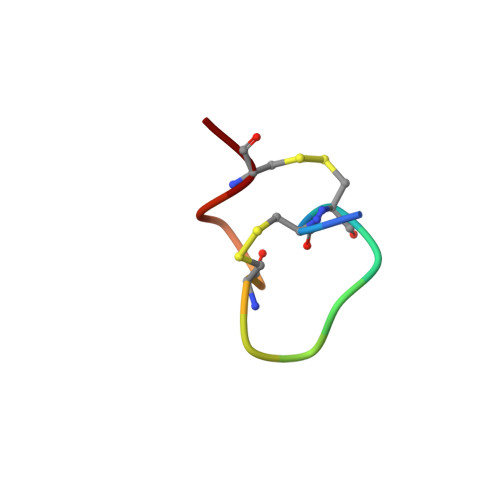Alpha-RgIA, a novel conotoxin that blocks the alpha9alpha10 nAChR: structure and identification of key receptor-binding residues.
Ellison, M., Feng, Z.P., Park, A.J., Zhang, X., Olivera, B.M., McIntosh, J.M., Norton, R.S.(2008) J Mol Biol 377: 1216-1227
- PubMed: 18295795
- DOI: https://doi.org/10.1016/j.jmb.2008.01.082
- Primary Citation of Related Structures:
2JUQ, 2JUR, 2JUS, 2JUT - PubMed Abstract:
Alpha-conotoxins are small disulfide-constrained peptides from cone snails that act as antagonists at specific subtypes of nicotinic acetylcholine receptors (nAChRs). The 13-residue peptide alpha-conotoxin RgIA (alpha-RgIA) is a member of the alpha-4,3 family of alpha-conotoxins and selectively blocks the alpha9alpha10 nAChR subtype, in contrast to another well-characterized member of this family, alpha-conotoxin ImI (alpha-ImI), which is a potent inhibitor of the alpha7 and alpha3beta2 nAChR subtypes. In this study, we have altered side chains in both the four-residue and the three-residue loops of alpha-RgIA, and have modified its C-terminus. The effects of these changes on activity against alpha9alpha10 and alpha7 nAChRs were measured; the solution structures of alpha-RgIA and its Y10W, D5E, and P6V analogues were determined from NMR data; and resonance assignments were made for alpha-RgIA [R9A]. The structures for alpha-RgIA and its three analogues were well defined, except at the chain termini. Comparison of these structures with reported structures of alpha-ImI reveals a common two-loop backbone architecture within the alpha-4,3 family, but with variations in side-chain solvent accessibility and orientation. Asp5, Pro6, and Arg7 in loop 1 are critical for blockade of both the alpha9alpha10 and the alpha7 subtypes. In loop 2, alpha-RgIA [Y10W] had activity near that of wild-type alpha-RgIA, with high potency for alpha9alpha10 and low potency for alpha7, and had a structure similar to that of wild type. By contrast, Arg9 in loop 2 is critical for specific binding to the alpha9alpha10 subtype, probably because it is larger and more solvent accessible than Ala9 in alpha-ImI. Our findings contribute to a better understanding of the molecular basis for antagonism of the alpha9alpha10 nAChR subtype, which is a target for the development of analgesics for the treatment of chronic neuropathic pain.
Organizational Affiliation:
Department of Biology, University of Utah, Salt Lake City, UT 84112, USA.














